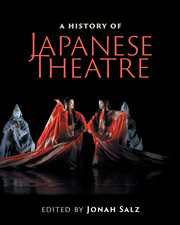Book contents
- Frontmatter
- Contents
- List of figures
- List of tables
- Contributors
- Contributors’ biographies
- Foreword
- Acknowledgments
- Note on Japanese terms
- List of abbreviations
- Timeline
- Editor's introduction
- I Traditional theatres
- Preface to Part I Japanese civilization arises
- 1 Ancient and early medieval performing arts
- Interlude Katari narrative traditions: from storytelling to theatre
- 2 Noh and Muromachi culture
- Interlude Noh and kyogen costumes and masks
- 3 Kyogen: classical comedy
- Interlude Iemoto : the family head system
- 4 Kabuki: superheroes and femmes fatales
- Interlude Nihonbuyo: classical dance
- Interlude Okinawan theatre: boundary of Japanese theatre
- 5 Bunraku: puppet theatre
- Interlude Misemono and rakugo : sideshows and storytelling
- Interlude Kamigata geinō : Kyoto-Osaka style
- Interlude Traditional theatre tomorrow: interview with Takemoto Mikio
- II Modern theatres
- Preface to Part II
- III Arcs and patterns
- IV Theatre architecture
- Preface to Part IV Evolution of Japanese theatre architecture
- V Theatre criticism
- VI Intercultural influences
- Epilogue: Frozen words and mythology
- Further reading
- Index
- References
4 - Kabuki: superheroes and femmes fatales
from Preface to Part I Japanese civilization arises
Published online by Cambridge University Press: 05 July 2016
- Frontmatter
- Contents
- List of figures
- List of tables
- Contributors
- Contributors’ biographies
- Foreword
- Acknowledgments
- Note on Japanese terms
- List of abbreviations
- Timeline
- Editor's introduction
- I Traditional theatres
- Preface to Part I Japanese civilization arises
- 1 Ancient and early medieval performing arts
- Interlude Katari narrative traditions: from storytelling to theatre
- 2 Noh and Muromachi culture
- Interlude Noh and kyogen costumes and masks
- 3 Kyogen: classical comedy
- Interlude Iemoto : the family head system
- 4 Kabuki: superheroes and femmes fatales
- Interlude Nihonbuyo: classical dance
- Interlude Okinawan theatre: boundary of Japanese theatre
- 5 Bunraku: puppet theatre
- Interlude Misemono and rakugo : sideshows and storytelling
- Interlude Kamigata geinō : Kyoto-Osaka style
- Interlude Traditional theatre tomorrow: interview with Takemoto Mikio
- II Modern theatres
- Preface to Part II
- III Arcs and patterns
- IV Theatre architecture
- Preface to Part IV Evolution of Japanese theatre architecture
- V Theatre criticism
- VI Intercultural influences
- Epilogue: Frozen words and mythology
- Further reading
- Index
- References
Summary
Kabuki is a vibrant traditional form, known worldwide for its colorful makeup, complex plots, beautiful dance, all-male performance tradition, intimate connection with the audience, broad, presentational, bravura acting, and integrated, cinematic use of music. Kabuki, which emerged alongside bunraku as the first commercial theatre forms in Japan, was largely nurtured by the commoner class, blossoming despite strict government regulation throughout the Tokugawa (Edo) period (1603–1868). When Japan was forcibly opened to the West in the Meiji era (1868–1912), kabuki responded to vast and rapid changes as leaders sought to remake this popular theatre form into one capable of representing a modern nation.
Rising nationalism with the spread of the Pacific War prompted renewed censorship and censure, but kabuki again adapted by creating new stage works to support the war effort. After World War II, kabuki reemerged with the more “classical” persona by which it is known today. Four centuries of accommodating public interests, artistic strengths, technological developments, and political changes have generated the living tradition of twenty-first-century kabuki, with markers of its evolution and eclectic origins still visible in the variety of plays staged today.
ELEMENTS OF PERFORMANCE
Performance context
Today, the Theatre Division of entertainment conglomerate Shōchiku Company controls all permanent kabuki venues, with the exception of the National Theatre, and manages all kabuki actor contracts. Monthly programs in Japan generally run for twenty-five days, with the remaining five or six for rehearsal of the following month's production. The Kabuki-za (Tokyo) runs monthly programs year-round. The Shōchiku-za (Osaka), Minami-za (Kyoto), Misono-za (Nagoya), Hakata-za (Fukuoka), Shinbashi Embujō (Tokyo), and Kanamaru-za (Shikoku) have kabuki programs one to three months each year, while summer touring productions bring single performances to civic halls in areas not served by major theatres. Kabuki can thus be seen throughout the country. There have been over sixty overseas tours of “Grand Kabuki” since World War II, giving 110 performances in ninety-six cities throughout Europe, North America, Asia, and Africa.
Programs at Shōchiku theatres consist of a late morning and an early evening show of about four hours each, offering a balance of dance pieces (shosagoto), excerpted highlight acts from popular traditional plays, and shorter one- or two-act shin (new) kabuki.
- Type
- Chapter
- Information
- A History of Japanese Theatre , pp. 102 - 140Publisher: Cambridge University PressPrint publication year: 2016
References
- 1
- Cited by



